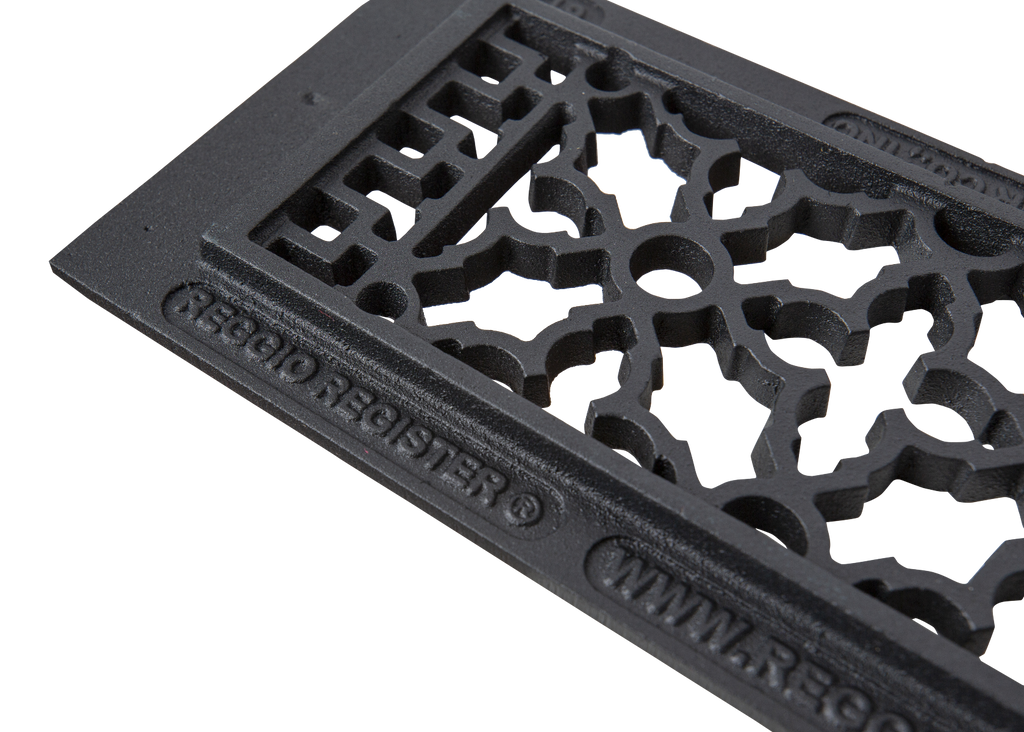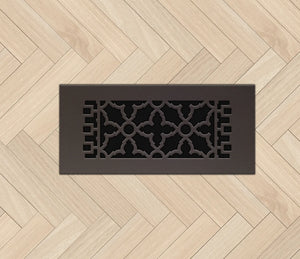Best Register Covers: Choosing the Right Material
When it comes to choosing a vent cover (register, or grille) the material it’s made out of should be a top concern. The material dictates how the register looks, its durability, and where you can use it.
Some register materials are better than others for the floor. Some are better than others for the ceiling. Let’s dig into register materials to find your perfect match.
Without further ado, here’s a study of the best register covers by material.
|
In This Article: Aluminum Steel Cast Iron Wood |

Aluminum Vent Covers
- Lightweight
- Rust Proof
- Lifetime Guarantee
- Cast or Laser Cut
Available in some of our most classic designs (Scroll and Square), aluminum covers for floor vents come in our full line up of colors or you can order it in Gray and paint it to your specifications (use paint for metal).
They are the lightest weight in our collection making them an excellent choice for ceiling or wall installations. Limit them to low-traffic areas on the floor where there is less chance of them being walked on (cast aluminum registers can be used for high-traffic floor installations).
Aluminum is rust-proof and is the ideal choice for registers in the bathroom, outdoors, or other damp environments. Our aluminum vent covers have a lifetime guarantee and will do the job (and look good doing it) for many years to come.
Shop Aluminum Covers
Steel Vent Covers
- Handcrafted & Hand Finished
- Solid High-Quality Steel
- Laser-Cut Steel
- Powder Coated
Exclusively a part of our Heritage Collection, Square steel registers and grilles are a winning choice for any space, which is what makes them so popular among architects, designers, and homeowners alike.
Steel covers for floor vents are laser cut then finished by hand from high-quality steel. They are available in six colors or you can order Gray and paint it to match your decor (we recommend metal paint). Not recommended for high-traffic floors.
Shop Steel Vent Covers
Cast Iron
- Authentic
- High Traffic
- Powder Coated
- Lifetime Guarantee
The standard in historic homes, cast iron registers in vintage styles that meet today’s demands, are hard to come by. Reggio specializes in replicating the artistry and craftsmanship of original cast iron vent covers.
Every register and grille is powder coated for a durable finish that doesn’t interfere with the authentic look. It also adds extra strength and protection for high-traffic floor installations. They can also be used for the wall or ceiling but are heavier than aluminum. Not recommended for high-moisture areas.
The cast iron covers for floor vents come with a lifetime guarantee.

Wood
- Quality Wood
- Exotic Woods Available
- Handcrafted
The perfect choice for a seamless look on your wood floor, wood covers for floor vents are made with the same attention to detail that our metal registers are made with. They are available in oak, cherry, and maple or custom exotic woods from alder to walnut.
Registers come finished with stain and a clear lacquer or you can order unfinished to perfectly match your wood floors and decor.
Strong enough for floor installations in high-traffic areas, wood vent covers are beautiful and durable.
Shop Wood Vent Covers
Whatever the material, you can count on Reggio Register to always offer the colors, styles, and materials that fit the bill. Want to explore more best register covers?
Explore the Full Collection
Sign up for exclusive offers and be the first to know about new developments at Reggio Register.


